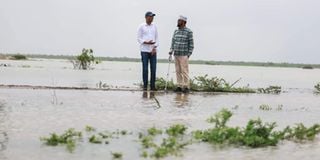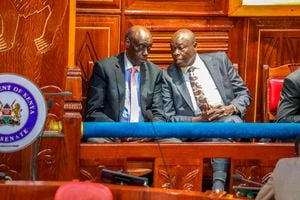2.4 million people affected by El Niño floods in Somalia

Somalia Prime Minister (left in white shirt) with Somalia’s Jubbaland State President Ahmed Mohamed Islam alias Madobe on 27 November 2023.
What you need to know:
- 2.4 million people have been affected by floods, and December could be more painful, according to predictions by Somalia’s Disaster Ministry.
- 120 deaths reported in the first 10 days of December, according to official figures.
Somalia is counting the cost of the El Niño season, with 120 deaths reported in the first 10 days of December, according to official figures.
This week, Prime Minister Hamza Barre toured parts of southern Somalia, particularly South West and Jubbaland states, where communities have been stranded because of water from torrential rains.
On the outskirts of Kismayu town, the capital of Jubbaland state, displaced people told him stories of survival, as he met with Jubbaland state president Ahmed Mohamed Islam Madobe, who demonstrated the flood patterns on a map.
Some of the displaced people have settled about 45 km from Kismayu. One mother of three said they had spent nights in the open with nothing to cover them. Kismayu is not the only troubled area in Somalia. Since rains began to batter the country and the Horn of Africa in October, at least a million more people have been forced from their homes in Somalia.
At least 8 million people, half the country's population, were already facing problems from the drought that hit the country last year. The floods will add to the number of people displaced, cut off from transport networks or supplies, or suffering from diseases linked to the torrential rains.
“Humanitarian partners are targeting 225,000 learners including children enrolled but at risk of dropping out of school due to impact of the floods,” said a local humanitarian bulletin known as the Deyr Season Floods Weekly Situation Report No. 3.
Rivers such as the Juba River, one of the perennial water courses in Somalia burst their banks destroying crops and homes in its wake. That affected districts in Gedo region including Dolo, Luq, Bardhere, and Burdhubo. Further downstream, the river bursting its banks also affected Jilib, Jamama and Goobwayn settlements.
Last week, President Hassan Sheikh Mohamud told a forum at the CoP28 in Dubai, United Arab Emirates, that some 2.4 million people had been affected by floods, warning that December could be more painful, according to predictions by the Disaster Ministry.
The floods have also affected some 2.4 million people in the country, rendering them unable to access food. Mohamud was in Dubai advocating for damage funds, equitable climate finance and global unity, reiterating actions being crucial for combating the current reality.
“Somalia is at the forefront of the countries directly affected by the issue of climate change, and the example of our people dealing with the floods caused by the El Niño storm is evident in those who have already overcome the drought that hit the country.”
In Beledweyne town, the capital of Hiran region in Hirshabelle State, 335 km north of Mogadishu, Shabelle River, burst its banks more than three weeks ago and it filled with water all streets and roads in less than 24 hours.

A street in Beledweyne town, the capital of Hiran region in Hirshabelle State, 335 km north of Mogadishu, turned like Venezia (Italy’s Venice) on 24 November 2023.
Shipowner Mahdi Nur Ahmed, hardly had enough time to collect the bagaash (grocery) that filled the shelves. Luckily, with the help of some friends and porters, he managed to recover about half of the items and took them to Eel Jaalle area just below the Jento Kundishe hill.
Ahmed told The EastAfrican he ventured several times to the town’s business area to place the remaining stocks on higher shelves, though he had seen traders losing sugar, dates and other stuff. They had little chance to evacuate.
“I am very lucky to have taken some of my groceries to the outskirts of the town, placing the remaining inventory on higher shelves,” said Ahmed, adding that locked stores are vulnerable to robbery.
“I keep on checking my store daily, partly swimming in the filled roads and partly negotiating my way by moving through waters at waist level,” he added, saying he is scared of crocodiles and snakes.
Ms Nadar Tibah Malin, the Mayor of Beledweyne, had stated 10 days ago that three kids died of hunger in the isolated Bundaweyn, one of the town’s four sections after the bridge became inaccessible.
“We had received three flights with aid foods, but far from being enough,” Ms Malin voiced out, stating that 15 persons perished as a result of the inundations.

Flooding that has been experienced in Somalia.
Somali Minister for Health Dr Ali Haji Adan told the media before the end of November that the situation in many parts of the country was already grave, especially due to floods in central and southern parts of the country.
“I am worried that diseases and other waterborne maladies may plague communities that were already devastated and displaced by the heavy rains caused by El Niño,” Dr Adan told the local media in clear reference to the weather phenomenon also referred as Indian Ocean Dipole. At the time, the death toll was at 96.
The World Health Organisation (WHO) was working with partners to scale up “the implementation of cholera response activities in districts (in Somalia) affected by floods from El Niño season.”
Somali Disaster Management Agency (SODMA) associate said there is a rapidly growing poor health with the uncontrollable inundations and it was striving to do all it can to alleviate them.
SODMA Director Mohamud Moalim Elmi Abdullahi said, “More rains are expected over the coming days, causing more flooding, which could cause deaths and destruction.”





